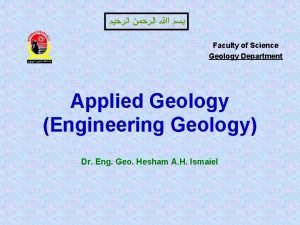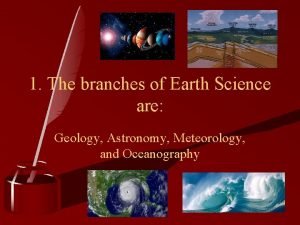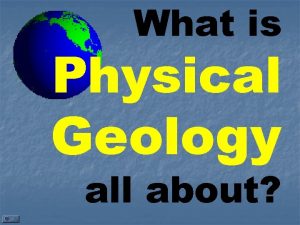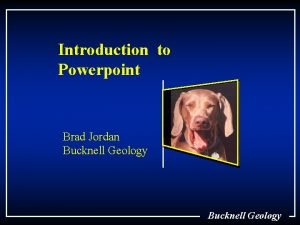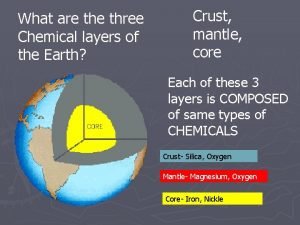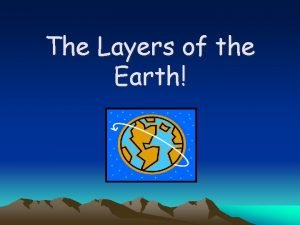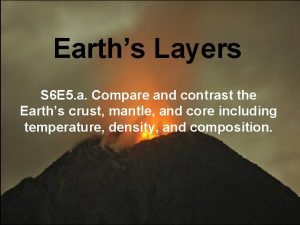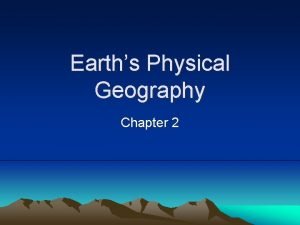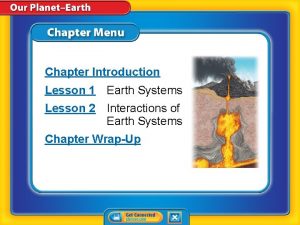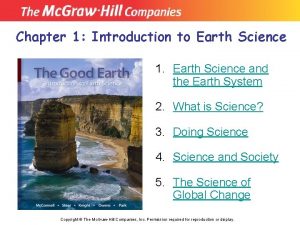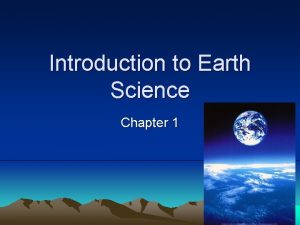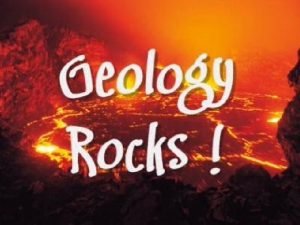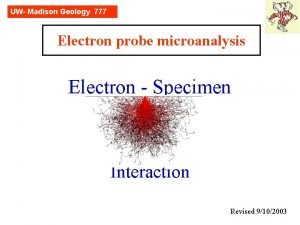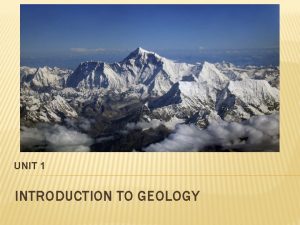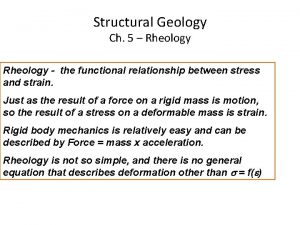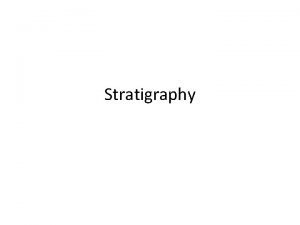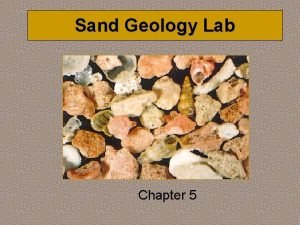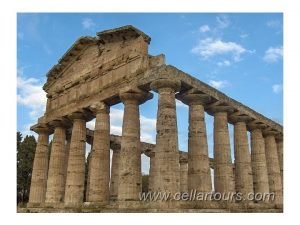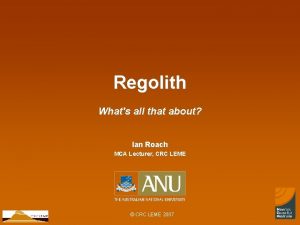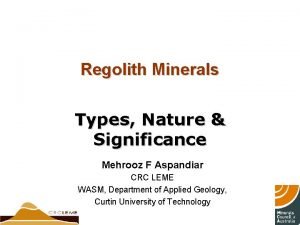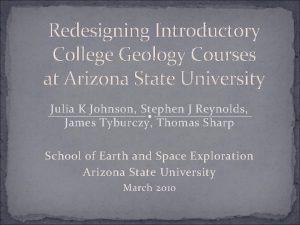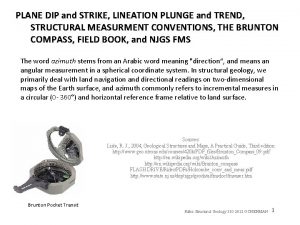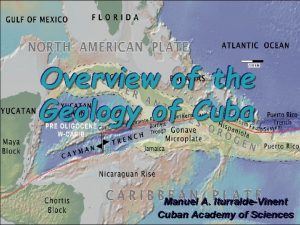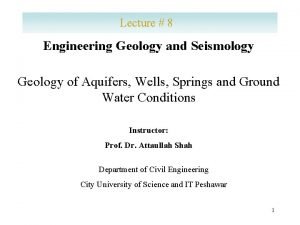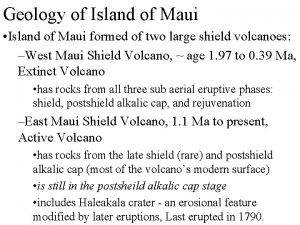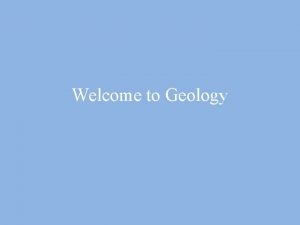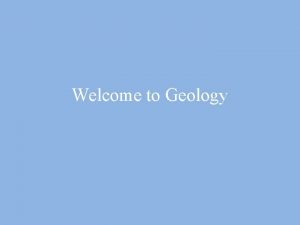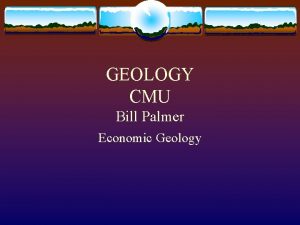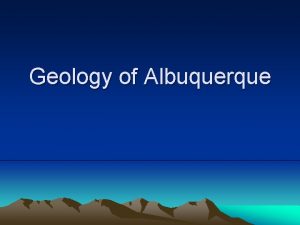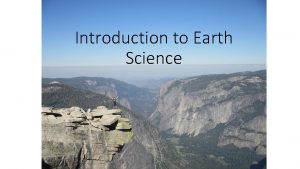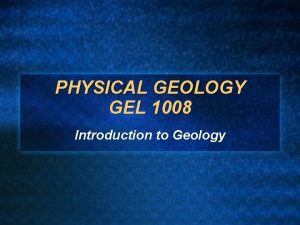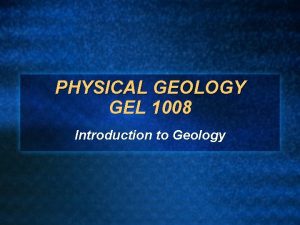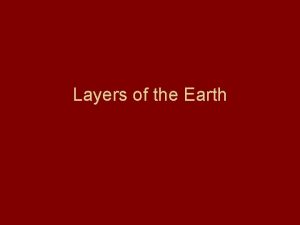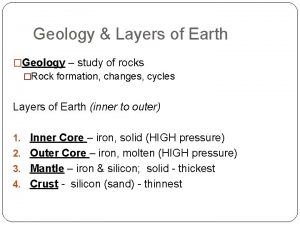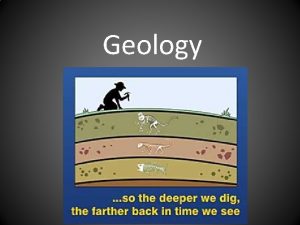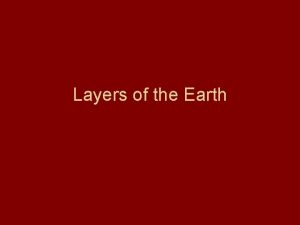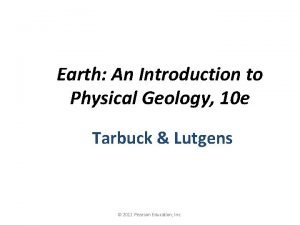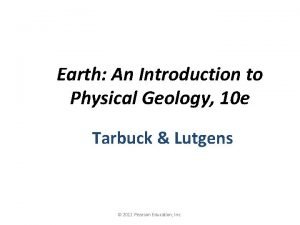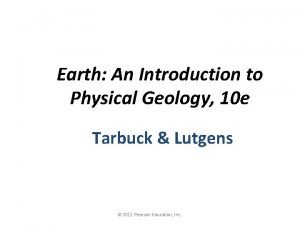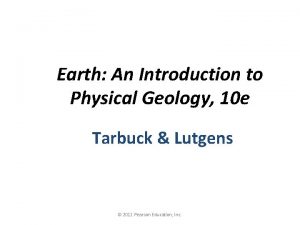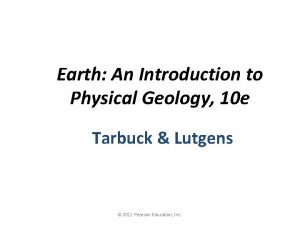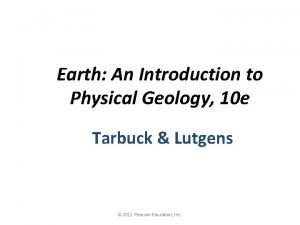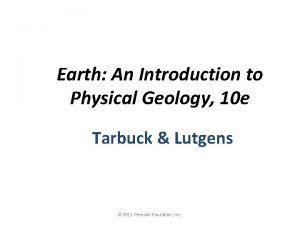Earth An Introduction to Physical Geology 10 e






























- Slides: 30

Earth: An Introduction to Physical Geology, 10 e Tarbuck & Lutgens © 2011 Pearson Education, Inc.

Weathering and Soil Earth, 10 e - Chapter 6 Stan Hatfield Southwestern Illinois College © 2011 Pearson Education, Inc.

Earth’s External Processes • Weathering—the physical breakdown and chemical decomposition of rock • Mass wasting—the transfer of rock and soil downslope under the influence of gravity • Erosion—the physical removal of material by water, wind, ice, or gravity © 2011 Pearson Education, Inc.

Weathering • Two types: 1. Mechanical weathering—breaking of rocks into smaller pieces 2. Types of mechanical weathering – – Frost wedging Unloading Thermal expansion Biological activity © 2011 Pearson Education, Inc.

Sheeting and Exfoliation Due to Unloading © 2011 Pearson Education, Inc.

Weathering • Chemical weathering • Breaks down rock components and internal structures of minerals • The most important agent is water. – Responsible for transport of ions and molecules involved in chemical processes © 2011 Pearson Education, Inc.

Weathering • Major processes of chemical weathering • Dissolution – Aided by small amounts of acid in the water • Oxidation – Any reaction when electrons are lost from one element • Hydrolysis – The reaction of any substance with water. – A hydrogen ion attacks and replaces other ions. © 2011 Pearson Education, Inc.

Weathering • Alterations caused by chemical weathering • Decomposition of unstable minerals • Formation or retention of stable materials • Physical changes such as the rounding of corners or edges © 2011 Pearson Education, Inc.

Products of Weathering © 2011 Pearson Education, Inc.

Rates of Weathering Factors affecting weathering • Surface area • Rock characteristics – Rocks containing calcite (marble and limestone) readily dissolve in weakly acidic solutions. – Silicate minerals weather in the same order as their order of crystallization. © 2011 Pearson Education, Inc.

Surface Area and Chemical Weathering © 2011 Pearson Education, Inc.

Rates of Weathering • Climate – Temperature and moisture characteristics – Chemical weathering is most effective in areas of warm, moist climates. • Differential weathering – Rocks do not weather uniformly due to regional and local factors. – Results in many unusual and spectacular rock formations and landforms © 2011 Pearson Education, Inc.

Spheroidal Weathering of Extensively Jointed Rock © 2011 Pearson Education, Inc.

Differential Weathering in Bryce Canyon National Park, Utah © 2011 Pearson Education, Inc.

Soil • Soil = mineral and organic matter + water + air • Rock and mineral fragments produced by weathering (regolith) that support the growth of plants • Humus (decayed animal and plant remains) is a small, but essential component. © 2011 Pearson Education, Inc.

Composition of a “Good” Soil © 2011 Pearson Education, Inc.

Soil • Factors controlling soil formation • Parent material – Residual versus transported soil • Time – Amount of time for soil formation varies depending on geologic and climatic conditions. © 2011 Pearson Education, Inc.

Soil • Climate – Most influential control of soil formation – Key factors are temperature and precipitation. • Plants and animals – Influence the soil’s physical and chemical properties • Topography – Steep slopes often have poorly developed soils. – The optimum terrain is a flat-to-undulating upland surface. © 2011 Pearson Education, Inc.

Variations in Soil Development © 2011 Pearson Education, Inc.

Soil • The soil profile • Soil-forming processes operate from the surface downward. • Vertical differences are called horizons, which are zones or layers of soil. – O horizon—organic matter – A horizon—organic and mineral matter » High biological activity » O and A horizons make up the topsoil © 2011 Pearson Education, Inc.

Soil • Soil profile – E horizon—little organic matter » Zone of eluviation and leaching – B horizon—zone of accumulation – C horizon—partially altered parent material • Collectively, the O, A, E, and B horizons make up the solum, or “true soil. ” © 2011 Pearson Education, Inc.

Idealized Soil Profile © 2011 Pearson Education, Inc.

Soil Profile Showing Different Horizons © 2011 Pearson Education, Inc.

Soil • Classifying soils • Variations in soil formation over time and distances has led to a great variety of recognized soil types. • Groups have been established using common characteristics. • In the United States, a system was devised, and called the Soil Taxonomy. © 2011 Pearson Education, Inc.

Soil • Classifying soils • Soil Taxonomy – Emphasis is placed on physical and chemical properties. – Six hierarchical categories exist. – Descriptive names are derived from Latin and Greek. – 12 basic soil orders are recognized. © 2011 Pearson Education, Inc.

Basic Soil Orders © 2011 Pearson Education, Inc.

Soil • Soil erosion • Part of the natural recycling of all Earth materials • Natural rates of soil erosion depend on: – Soil characteristics – Climate – Slope – Type of vegetation © 2011 Pearson Education, Inc.

Soil Erosion Where Vegetation Is Lacking © 2011 Pearson Education, Inc.

Soil • In many regions, soil erosion is much greater than the rate of soil formation. • Sedimentation and chemical pollution – Related to excessive soil erosion – Occasionally, soil particles are contaminated with pesticides. © 2011 Pearson Education, Inc.

End of Chapter 6 © 2011 Pearson Education, Inc.
 Geology earth science definition
Geology earth science definition Astronomy definition earth science
Astronomy definition earth science Zone of aeration
Zone of aeration Earth science vs geology
Earth science vs geology Define physical geology
Define physical geology Introduction to geology ppt
Introduction to geology ppt Earth chemical layers
Earth chemical layers Layers of the earth's crust
Layers of the earth's crust What are earth's physical layers
What are earth's physical layers 2 type of crust
2 type of crust Earth physical features
Earth physical features Earth's physical geography chapter 2
Earth's physical geography chapter 2 Earths physical features
Earths physical features Lesson 1: introduction to the earth
Lesson 1: introduction to the earth Chapter 1 introduction to earth science
Chapter 1 introduction to earth science Earth science introduction
Earth science introduction Geology is the study of
Geology is the study of Uw
Uw Geology what is
Geology what is Geology
Geology What is stratigraphy
What is stratigraphy Geology lecture series
Geology lecture series Grain size card
Grain size card What is differential stress
What is differential stress Regolith geology
Regolith geology Regolith geology
Regolith geology Arizona state university geology
Arizona state university geology Plunge geology
Plunge geology Geology of cuba:
Geology of cuba: Aquitard definition geology
Aquitard definition geology Maui geology
Maui geology
